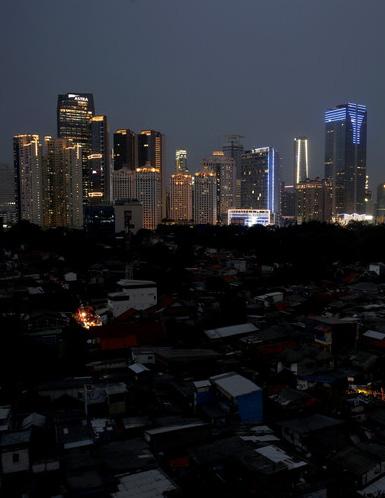
9 minute read
Malta Insights
CorporateDispatchPro

10% OF PEOPLE IN MALTA LIVE IN DARK DWELLINGS – EUROSTAT
Just under 10% of people in Malta, the third highest rate in the European Union, reported not having enough daylight in their dwelling, meaning their dwelling seemed too dark and was viewed as a problem for the household.

Data published by Eurostat shows that across the bloc, some 5.9% of people reported similar conditions. The data updated to the end of 2020.
Access to daylight in dwellings helps improve the health and wellbeing, while it can also help improve energy efficiency by reducing the need for artificial lighting.

In 2020, over 10% of people living in Spain considered their dwelling too dark (10.6%), which was the highest share recorded among the EU Member States. Spain was followed by France (9.5%; provisional data), Malta (9.4%) and Hungary (7.7%). In contrast, the lowest shares were recorded in Slovakia (2.6%, provisional data), Italy (2.6%, 2019 data), Cyprus (2.8%) and Czechia (3.1%).
MALTA: DEFICIT CLIMBS TO OVER €900M BY SEPTEMBER
By the end of September 2021, the Government’s Consolidated Fund reported a deficit of €906.8 million, the NSO reported today.
In the first nine months of 2021, Recurrent Revenue amounted to €3,627.0 million, 23.8 per cent higher than the €2,930.3 million reported a year earlier. The largest increase was recorded under


Income Tax (€351.5 million), followed by Value Added Tax (€175.6 million) and Social Security (€140.1 million).
On the other hand, total expenditure stood at €4,533.8 million, 11.4 per cent higher than the previous year. During the reference period, Recurrent Expenditure totalled €3,965.1 million, a rise of €644.9 million in comparison to the €3,320.2 million reported by the end of September 2020.
The main contributor to this increase was a €534.4 million rise reported under Programmes and Initiatives. Furthermore, increases were also witnessed under Personal Emoluments (€81.0 million) and Contributions to Government Entities (€32.8 million).
The largest development in the Programmes and Initiatives category was related to the Pandemic assistance scheme (€278.4 million), which includes the COVID-19 Business Assistance Programme. Other increases under Programmes and Initiatives were reported under EU own resources (€78.2 million) and Hospital concession agreements (€31.6 million).
The interest component of the public debt servicing costs totalled €137.1 million, a decrease of €1.6 million when compared to the previous year.
By the end of September 2021, Government’s capital spending amounted to €431.6 million, €178.8 million lower than 2020. The drop largely resulted from the reclassification of the COVID-19 Business Assistance Programme (€237.0 million), which featured under Capital Expenditure between March and December 2020 but is now classified under Recurrent Expenditure. This decline outweighed an increase of €58.2 million reported in other capital projects.
MALTA: DECLINE IN TAX REVENUE SHOWS EXTEND OF PANDEMIC IMPACT
Total tax revenue in 2020 decreased by €317.9 million over the previous year, amounting to €3,973.8 million, the NSO said today. This sheds further light on the adverse economic impact of the pandemic, as well as Government measures aimed at mitigating the crisis, particularly the tax deferral scheme.
Indirect taxes amounted to €1,420.3 million or 35.7 per cent of total tax revenue, a decrease of €218.2 million from 2019. This drop was mainly triggered by lower Taxes on Production (€134.3 million), following declines in duty on


CorporateDispatchPro
documents (€62.5 million) excise levies (€53.4 million) and motor vehicle registration tax (€11.9 million).
Furthermore, Value Added Tax (VAT) also dropped by €83.2 million over the preceding year. The second largest decrease was recorded in direct taxes, which declined by €140.6 million, for a total of €1,712.5 million, equivalent to 43.1 per cent of total tax revenue. The two key components of direct taxes, namely Personal and Corporate Income Tax were also signifi cantly aff ected by the pandemic. Corporate Income tax declined by €159.9 million over 2019, while Personal Income Tax registered an increase of €25.6 million, though at a slower pace when compared to previous years.
Social contributions paid by employees, employers and self- and non-employed persons represented 21.2 per cent of total tax revenue in 2020, standing at €841.1 million. An increase of €41.0 million over 2019 was registered, reflecting the resilience of the labour market.
The overall tax burden denotes the total amount of taxes and social contributions, expressed as a percentage of GDP. In 2020, the tax burden for Malta was 30.4 per cent of GDP, which reflects a decrease of 0.2 percentage points when compared to the total tax burden of 30.6 per cent of GDP recorded in 2019. Over the past 10 years, the total tax burden has been consistently above 30 per cent of GDP, with the lowest rate recorded in 2020, while the average tax burden for the 1995 to 2020 period stands at 30.7 per cent.
By the end of last year, direct taxes (which also include Capital taxes) amounted to 13.1 per cent of GDP, compared to the share of indirect taxes which stood at 10.9 per cent. Meanwhile, the share of Social contributions stood at 6.4 per cent of GDP, increasing by 0.7 percentage points over 2019.
MALTA OUTPERFORMS EU IN EMPLOYMENT RATES, LACKS IN EDUCATIONAL ATTAINMENT
Malta’s employment and activity rates continue to surpass EU averages, according to an analysis of labour force numbers carried out by the National Statistics Office, but lags behind in a number of education-related criteria.

Achieving financial ambitions



Our team of professionals takes a personal interest in your investment objectives with tailor-made portfolio planning and superior quality service. You can trust our long-term conservative approach to reach your financial ambitions.


CorporateDispatchPro
Over the last six years, the activity rate – that is either in employment or still in education, for the 15-64 age group rose from 68.8 per cent in 2015 to 77.1 per cent in 2020. Females played an important role in labour market growth. In this regard, the female activity rate increased 12.1 percentage points. On the other hand, the contribution of males to the overall increase in activity rate was of 3.9 percentage points between 2015 and 2020.
The highest activity rate was recorded among those aged 25 to 54. On average, out of every 100 males aged between 25 and 54 years, 96 were active. For females in this age group, activity rates registered a substantial increase and in fact between 2015 and 2020, there was a rise of 11.9 percentage points.
The overall national activity rate (15-64 years) for 2020 was 4.2 percentage points higher than that recorded for EU27. National activity rates were higher than EU 27 indicators for all age groups except for the 55 to 64 year olds.
In fact, in spite of the considerable growth observed over the past six years, EU 27 activity rates for the 55 to 64 age group were found to be 8.2 percentage points higher than national rates.
Employment and Unemployment: In 2020, on average, out of every 100 persons aged between 15 and 64 years, 74 were employed. During these years, male employment rates increased by an average of 0.9 percentage points per year whereas female rates increased by an average of 2.4 percentage points per annum. At a national level, more males and females tend to be in employment when compared to the EU 27 average. The largest gap was recorded for the 15 to 24 year olds with the national employment rate recorded at 48 per cent as compared with 31.5 per cent for the EU 27. On the other hand, the 55 to 64 age bracket showed that the EU 27 employment rates were 6.9 percentage points higher than national rates.
Unemployment rates have been declining steadily during the past years, however during 2020 the rate increased again to 4.4 per cent. In 2020, the male and female unemployment rates stood at 4.3 and 4.5 per cent respectively. When comparing to

EU 27 levels, national rates for 2020 were lower for both sexes across all age groups. The largest diff erences between EU 27 levels and national rates were however prevalent in the younger cohort where, the difference was 3.6 percentage points for males and 8.5 percentage points for females.
EDUCATION
Another Europe 2020 headline indicator is the rate of early leavers from education and training (ELET). In 2020, the ELET rate stood at 12.6 per cent, recording a drop of 3.7 percentage points from 2015 levels. The ELET rate registered a decrease for both males and females at 4.5 and 2.9 percentage points respectively over the last six years.
Although Malta’s levels for the early leavers from education and training indicator declined significantly over the years, national values were still higher when compared to European averages. In 2020, the rate was 2.6 percentage points higher than the EU 2020 national target of 10 per cent. At the same time, data for 2020 show that the number of persons aged 20 to 24 years achieving at least an upper secondary level of education was 85.1 per cent, with the national rate being 0.8 percentage points higher than the EU 27 average.
Another Europe headline indicator is the tertiary educational attainment for the 30 to 34 year age group. Within this age group, there has been an increasing trend of persons attaining tertiary education for both males and females. Tertiary educational attainment increased by 10.7 percentage points over the past six years. In 2020, tertiary educational attainment stood at 39.8 per cent, hence surpassing the EU 2020 national target of 33 per cent.
83% OF MALTESE USE INTERNET EVERY DAY – EUROSTAT
The percentage of adults (16 to 74-year-olds) in Malta who use the internet every day has risen in line with EU levels, to 83% in 2020, three points above the EU average.
Data published by Eurostat, which focused on regions, found that in 2020, the majority of northern and western regions of the
CorporateDispatchPro

EU reported relatively high proportions of adults using the internet on a daily basis; the highest shares of adults using the internet every day were generally recorded among people living in cities rather than those living in rural areas.
The highest share of adults making daily use of the internet was recorded in Helsinki-Uusimaa in Finland (96%). This was closely followed by Hovedstaden in Denmark, Stockholm in Sweden (both 95%) and another 2 regions in Denmark: Syddanmark and Midtjylland (both 94%). On the other hand, the lowest share of adults making daily use of the internet was recorded in Severozapaden in Bulgaria (53%). This was closely followed by the region Nord-Est in Romania (55%) and three other regions in Bulgaria: Severen tsentralen (also 55%), Yugoiztochen and Yuzhen tsentralen (both 56%).
In some countries, there were significant regional discrepancies: for example in Italy, the affluent region of Emilia-Romagna saw usage reach 83%, while that in Sicily was anchored at a lowly 68%.









